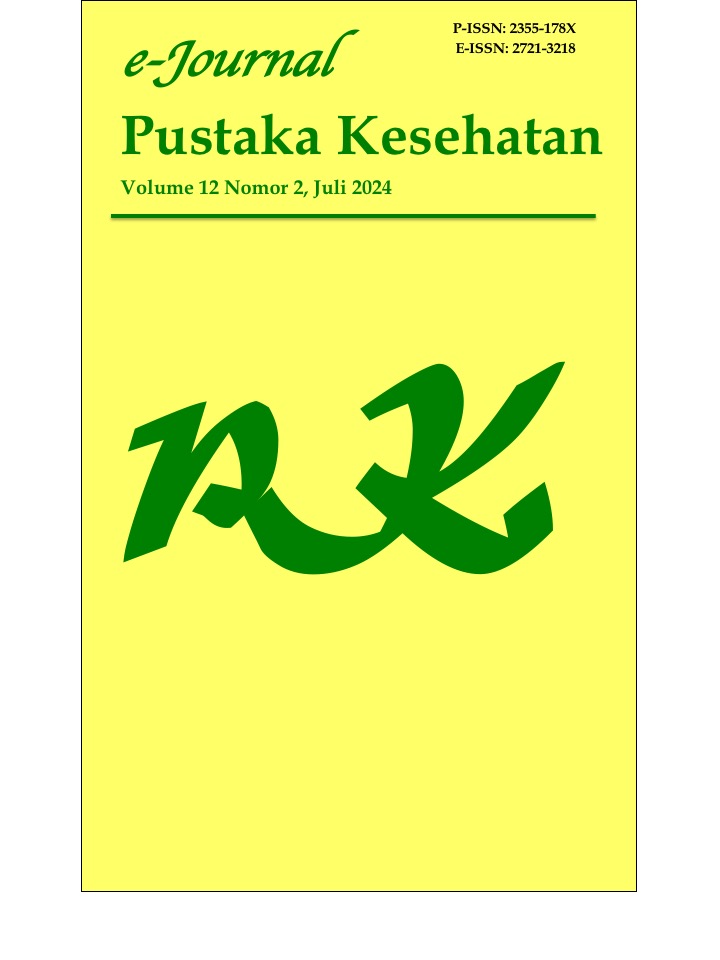Hubungan Lingkar Perut dengan Kadar Gula Darah pada Petani: Analisa Data Posbindu PTM Puskesmas Sukorejo Jember 2020
DOI:
https://doi.org/10.19184/pk.v12i2.25209Keywords:
blood sugar, farmers, abdominal circumferenceAbstract
Farmer is the occupation of the majority of Indonesians, and they rank first as a contributor to hyperglycemia (32.4%) and third to diabetes (12.6%) in Indonesia. Diabetic disease is affected by several factors, including abdominal obesity. So, the Indonesian government established a program called Posbindu PTM to screen for non-communicable diseases in Indonesians. This research aimed to analyze the correlation between abdominal circumference and blood sugar levels of farmers in Sukorejo Public Health Center. The cohort retrospective study design was used to analyze data of KMS Posbindu PTM in 2020 using Chi Square analysis with a significance of p<0.05. Data on age, gender, and abdominal circumference for 3 consecutive months (January)-March were collected, and blood sugar levels were measured in the third month (March) from 35 selected samples. The result showed no relationship between abdominal circumference and blood sugar levels (p=0.380), but there is a significant difference between gender and abdominal circumference among farmers (p= 0.019). An insignificant relationship between abdominal circumference and blood sugar levels indicated that abdominal obesity is not the main factor of diabetes, and other factors can influence it. Therefore, the abdominal circumference should be monitored regarding gender to prevent increased blood sugar among farmers.
Downloads
References
[2] Evie K, Bella Y. 2016. Faktor-Faktor yang Berhubungan dengan Kejadian Diabetes Melitus Tipe. Majority. 5(2):27-31.
[3] Kementerian Kesehatan RI. 2018. Hasil Utama Riset Kesehatan Dasar. Jakarta: Kementerian Kesehatan Republik Indonesia.
[4] Soebagijo AS, Hermina N, Achmad R, Pradana S, Ketut S et al. 2015. Konsensus Pengelolaan dan Pencegahan Diabetes Mellitus Tipe 2 di Indonesia 2015. Jakarta: Perkeni.
[5] Marina DA, Mia S. 2019. Hubungan Lingkar Perut, Konsumsi Gula dan Lemak dengan Kadar Glukosa Darah Pegawai Direktorat Poltekkes Kemenkes Jakarta II. Nutrire Diaita. 11(1):7–17.
[6] Sandra R. 2015. Sindrom metabolik. Majority. 4(4):88-93.
[7] Tantut S, Retno P, Emi WW. 2017. Prevalence and Associated Factors of Health Problems among Indonesian Farmers. Chinese Nursing Research. 4(1):31–37.
[8] Dewi P, Triska SN. 2018. Hubungan Antara Ketersediaan Pangan dengan Keragaman Pangan Rumah Tangga Buruh Tani. Media Gizi Indonesia. 12(2): 149.
[9] Kementerian Kesehatan RI. 2019. Petunjuk Teknis Pos Pembinaan Terpadu “Posbindu†Bagi Kader. Jakarta: Kementerian Kesehatan Republik Indonesia.
[10] Agnes SVN, Maria MP, Yulita M, Tuty HP. 2020. Faktor yang Memengaruhi Kadar Gula Darah Penderita Diabetes Mellitus (DM) Tipe .Jurnal Dunia Gizi. 3(1):23–31.
[11] Rika L, Raka NC. 2016. Aktivitas Fisik Dalam Menurunkan Kadar Glukosa Darah Pada Diabetes Melitus Tipe 2. Majority. 5(3):140–144.
[12] Eva D. 2019. Diabetes Melitus Tipe 2. Edisi 1. Padang: Fakultas Kedokteran Universitas Andalas.
[13] Gusnilawati, Septiyani. 2018. Hubungan Aktifitas Fisik dengan Kejadian Obesitas Sentral Pada Pasien Poliklinik Jantung dan Penyakit Dalam. Jurnal Media Kesehatan. 9(2):160–164.
[14] Ratmayani, Rahmadanih , Darmawan S. 2018. Relasi Gender Pada Rumah Tangga Petani Cengkeh. Studi Kasus Rumah Tangga Petani Cengkeh Di Desa Seppong, Kecamatan Tammero’do, Majene, Sulawesi Barat. Jurnal Sosial Ekonomi Pertanian.4(1):65-75.
[15] Kristiawan PAN, Retno T, Shara MH. 2019. Identifikasi Kejadian Obesitas pada Lansia di Wilayah Kerja Puskesmas Sidorejo Kidul. Media Ilmu Kesehatan.7(3):213–222.
[16] Alvin W, Nyoman W, Ida APW. 2019. Hubungan Lingkar Perut dengan Kadar Gula Darah Puasa Pada Mahasiswa Fakultas Kedokteran Universitas Udayana Angkatan 2014 . Intisari Sains Medis. 10(2):279–283.
Downloads
Published
Issue
Section
License
e-Journal Pustaka Kesehatan has CC-BY-SA or an equivalent license as the optimal license for the publication, distribution, use, and reuse of scholarly work. Authors who publish with this journal retain copyright and grant the journal right of first publication with the work simultaneously licensed under a Creative Commons Attribution-ShareAlike 4.0 International License that allows others to share the work with an acknowledgment of the work's authorship and initial publication in this journal.



